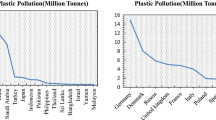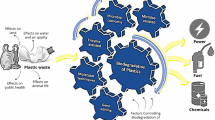Abstract
The accumulation of plastic waste is a pressing environmental problem, growing hand-in-hand with the rising production and consumption of consumer products. The robustness and intrinsic strength of plastics, which render them extremely useful in various packaging applications, are a double-edged sword as they are likewise highly resistant to degradation and may persist for several millennia. Conventional waste treatment solutions are increasingly unable to manage the growing volume of such waste, bringing us to the brink of ecological disaster. Interestingly, environmental microorganisms are beginning to evolve their own biological means of thriving within such environments through production of metabolic intermediaries that enable them to utilize plastics as energy sources. Here, we present a brief review of the current literature, highlighting various micro- and multicellular organisms that have been found to degrade plastics, as well as propose some strategies for industrialization of these processes in the future.
Similar content being viewed by others
References
Plastics Europe (2018) Plastics the facts 2017. https://www.plasticseurope.org/application/files/5715/1717/4180/Plastics_the_facts_2017_FINAL_for_website_one_page.pdf Accessed 26 April 2019
Arutchelvi J, Sudhakar M, Arkatkar A, Doble M, Bhaduri S, Uppara PV (2008) Biodegradation of polyethylene and polypropylene. Indian J Biotechnol 7:9–22. http://nopr.niscair.res.in/handle/123456789/7326
UNEP (2018) Single-use plastics. https://www.unenvironment.org/resources/report/single-use-plastics-roadmap-sustainability. Accessed 26 April 2019
Beaumont NJ, Aanesen M, Austen MC, Borger T, Clark JR, Cole M, Hooper T, Lindeque PK, Pascoe C, Wyles KJ (2019) Global ecological, social, and economic impacts of marine plastic. Mar Pollut Bull 142:189–195
World Economic Forum (2016) The New Plastics Economy. https://www.weforum.org/reports/the-new-plastics-economy-rethinking-the-future-of-plastics. Accessed 26 April 2019
Watson R (2018) Time is running out: The U.S. landfill capacity crisis. Waste business journal. https://nrra.net/sweep/time-is-running-out-the-u-s-landfill-capacity-crisis/ Accessed 15 April 2019
Mahmud AQ (2018) ‘Cannot sell so they burn’: what’s next in the uncertain future for plastic waste in Singapore? CNA. https://www.channelnewsasia.com/news/singapore/china-bans-plastic-waste-whats-next-for-recycling-in-singapore-10281026 Accessed 14 April 2019
de Castella T (2011) Tipping point: what happens when our landfills are full? The telegraph. https://www.telegraph.co.uk/news/earth/businessandecology/recycling/8849010/Tipping-point-what-happens-when-our-landfills-are-full.html Accessed 14 April 2019
Chen W, McCarthy TJ (1998) Chemical surface modifications of poly(ethylene terephthalate). Macromolecules 31:3648–3655
Arkatkar A, Juwarkar AA, Bhaduri S, Uppara PV, Doble M (2010) Growth of Psuedomonas and Bacillus biofilms on pretreated polypropylene surface. Int Biodeterior Biodegrad 64:530–536
Sheik S, Chandrashekar KR, Swaroop K, Somashekarappa HM (2015) Biodegradation of gamma irradiated low density polyethylene and polypropylene by endophytic fungi. Int Biodeterior Biodegrad 105:21–29
Brueckner T, Eberl A, Heumann S, Rabe M, Guebitz GM (2008) Enzymatic and chemical hydrolysis of poly(ethylene terephthalate) fabrics. J Poly Sci 46:6435–6443
Uekert T, Kuehnel MF, Wakerley DW, Reisner E (2018) Plastic waste as a feedstock for solar-driven H2 generation. Energy Environ 11:2853–2857
Ali SS, Qazi IA, Arshad M, Khan Z, Voice TC, Mehmood CT (2016) Photocatalytic degradation of low density polyethylene (LDPE) films using titania nanotubes. Environ Nanotechnol Monit Manag 5:44–53
Leja K, Lewandowicz G (2010) Polymer biodegradation and biodegradable polymers: a review. Pol J Environ Stud 19:255–266
Ronkvist AM, Xie W, Lu W, Gross RA (2009) Cutinase-catalyzed hydrolysis of poly(ethylene terephthalate). Macromolecules 42:5128–5138
Emadian SM, Onay TT, Demirel B (2017) Biodegradation of bioplastics in natural environments. Waste Manage 59:526–536
Bhardwaj H, Gupta R, Tiwari A (2012) Communities of microbial enzymes associated with biodegradation of plastics. J Polym Environ. https://doi.org/10.1007/s10924-012-0456-z
Tokiwa Y, Calabia BP, Ugwu CU, Aiba S (2009) Biodegradability of plastics. Int J Mol Sci 10:3722–3742
Arkatkar A, Arutchelvi J, Bhaduri S, Uppara PV, Doble M (2009) Degradation of unpretreated and thermally pretreated polypropylene by soil consortia. Int Biodeterior Biodegrad 63:106–111
Yoshida S, Hiraga K, Takehana T, Taniguchi I, Yamaji H, Maeda Y, Toyohara K, Miyamoto K, Kimura Y, Oda K (2016) A bacteria that degrades and assimilates poly(ethylene terephthalate). Science 351:1196–1199
Wei R, Zimmermann W (2017) Biocatalysis as a green route for recycling the recalcitrant plastic polyethylene terephthalate. Microb Biotechnol 10:1302–1307
Sulaiman S, Yamato S, Kanaya E, Kim JJ, Koga Y, Takano K, Kanaya S (2012) Isolation of a novel cutinase homolog with polyethylene terephthalate-degrading activity from leaf-branch compost by using a metagenomic approach. Appl Environ Microbiol 78(5):1556–1562
Muller RJ, Schrader H, Profe J, Dresler K, Deckwer WD (2005) Enzymatic degradation of poly(ethylene terephthalate): rapid hydrolyse using a hydrolyase from T. fusca. Macromol Rapid Commun 26:1400–1405
Sulaiman S, You DJ, Kanaya E, Koga Y, Kanaya S (2014) Crystal structure and thermodynamic and kinetic stability of metagenome-derived LC-cutinase. Biochemistry 53:1858–1869
Baker PJ, Poultney C, Liu Z, Gross R, Montclare JK (2012) Identification and comparison of cutinases for synthetic polyester degradation. Appl Microbiol Biotechnol 93:229–240
Tanasupawat S, Takehana T, Yoshida S, Hiraga K, Oda K (2016) Ideonella sakaiensis sp. nov., isolated from a microbial consortium that degrades poly(ethylene terephthalate). Int J Syst Evol Microbiol 66:2813–2818
Then J, Wei R, Oeser T, Barth M, Belisario-Ferrari MR, Schmidt J, Zimmermann W (2015) Ca2+ and Mg2+ binding site engineering increases the degradation of polyethylene terephthalate films by polyester hydrolases from Thermobifida fusca. Biotechnol J 10:592–598
Harshvardhan K, Jha B (2013) Biodegradation of low-density polyethylene by marine bacteria from pelagic waters, Arabian Sea, India. Mar Pollut Bull 77:100–106
Lwanga EH, Thapa B, Yang X, Gertsen H, Salanki T, Geissen V, Garbeva P (2018) Decay of low-density polyethylene by bacteria extracted from earthworm’s guts: a potential for soil restoration. Sci Total Environ 624:753–757
Volke-Sepulveda T, Saucedo-Castaneda G, Gutierrez-Rojas M, Manzur A, Favela-Torres E (2002) Thermally treated low density polyethylene biodegradation by Penicillum pinophilum and Aspergillus niger. J Appl Polym Sci 83:305–314
Gilan I, Hadar Y, Sivan A (2004) Colonization, biofilm formation and biodegradation of polyethylene by a strain of Rhodococcus ruber. Appl Microbiol Biotechnol 65:97–104
Hadad D, Geresh S, Sivan A (2005) Biodegradation of polyethylene by the thermophilic bacterium Brevibacillus borstelensis. J Appl Microbiol 98:1093–1100
Jeyakumar D, Chirsteen J, Doble M (2013) Synergistic effects of pretreatment and blending on fungi mediated biodegradation of polypropylenes. Bioresour Technol 148:78–85
Cacciari I, Quatrini P, Zirletta G, Mincione E, Vinciguerra V, Lupattelli P, Sermanni GG (1993) Isotatic polypropylene biodegradation by a microbial community: physiochemical characterization of metabolites produced. Appl Environ Microbiol 59:3700–4695
Atiq N, Ahmed S, Ali MI, Andleeb S, Ahmad B, Robson G (2010) Isolation and identification of polystyrene biodegrading bacteria from soil. Afr J Microbiol Res 4:1537–1541
Otake Y, Kobayashi T, Asabe H, Murakami N, Ono K (1995) Biodegradation of low-density polyethylene, polystyrene, polyvinyl chloride, and urea formaldehyde resin buried under soil for 32 years. J Appl Polym Sci 56:1789–1796
Mor R, Sivan A (2008) Biofilm formation and partial biodegradation of polystyrene by the actinomycete Rhodococcus ruber. Biodegradation 19:851–858
Schmidt FR (2005) Optimization and scale up of industrial fermentation process. Appl Microbiol Biotechnol 68:425–435
Sabra S, Zeng AP (2015) Mixed microbial cultures for industrial biotechnology: success, chance, and challenges. In: Grunwald P (ed) Industrial biocatalysis. CRC Press, Boca Raton, pp 205–237
Yang J, Yang Y, Wu WM, Zhao J, Jiang L (2014) Evidence of polyethylene biodegradation by bacterial strains from the guts of plastic-eating waxworms. Environ Sci Technol 48:13776–13784
Bombelli P, Howe CJ, Bertocchini F (2017) Poly-ethylene biodegradation by caterpillars of the wax moth Galleria mellonella. Curr Biol 27:R83–R293
Yang Y, Yang J, Wu WM, Zhao J, Song Y, Gao L, Yang R, Jiang L (2015) Biodegradation and mineralization of polystyrene by plastic-eating mealworms: part 1. chemical and physical characterization and isotopic tests. Environ Sci Technol 49:12080–12086
Yang Y, Yang J, Wu WM, Zhao J, Song Y, Gao L, Yang R, Jiang L (2015) Biodegradation and mineralization of polystyrene by plastic-eating mealworms: part 2 role of gut microorganisms. Environ Sci Technol 49:12080–12086
Akhtar Y, Isman MB (2018) Insects as an alternative protein source. In: Yada RY (ed) Proteins in food processing, vol 2. Elsevier, Amsterdam, pp 263–288
Bergmann M, Gutow L, Klages M (2015) Marine anthropogenic litter. Springer, New York
World Health Organization (2019) Health Effects of UV Radiation. https://www.who.int/uv/health/uv_health2/en/ Accessed 4 May 2019
Pellis A, Gamerith C, Ghazaryan G, Ortner A, Acero EH, Guebitz GM (2016) Ultrasound-enhanced enzymatic hydrolysis of poly(ethylene terephthalate). Bioresourc Technol 218:1298–1302
Acknowledgements
The authors are grateful to Entrepreneur First for funding support.
Author information
Authors and Affiliations
Corresponding author
Additional information
Publisher's Note
Springer Nature remains neutral with regard to jurisdictional claims in published maps and institutional affiliations.
Rights and permissions
About this article
Cite this article
Lee, A., Liew, M.S. Ecologically derived waste management of conventional plastics. J Mater Cycles Waste Manag 22, 1–10 (2020). https://doi.org/10.1007/s10163-019-00931-4
Received:
Accepted:
Published:
Issue Date:
DOI: https://doi.org/10.1007/s10163-019-00931-4




